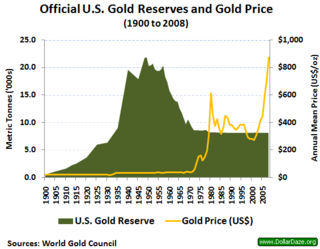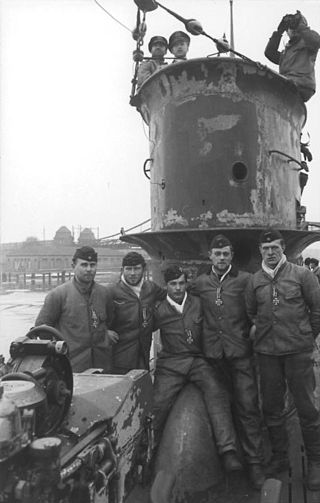
The Dunkirk evacuation, codenamed Operation Dynamo and also known as the Miracle of Dunkirk, or just Dunkirk, was the evacuation of more than 338,000 Allied soldiers during the Second World War from the beaches and harbour of Dunkirk, in the north of France, between 26 May and 4 June 1940. The operation commenced after large numbers of Belgian, British, and French troops were cut off and surrounded by German troops during the six-week Battle of France. In a speech to the House of Commons, British Prime Minister Winston Churchill called this "a colossal military disaster", saying "the whole root and core and brain of the British Army" had been stranded at Dunkirk and seemed about to perish or be captured. In his "We shall fight on the beaches" speech on 4 June, he hailed their rescue as a "miracle of deliverance".

A gold reserve is the gold held by a national central bank, intended mainly as a guarantee to redeem promises to pay depositors, note holders, or trading peers, during the eras of the gold standard, and also as a store of value, or to support the value of the national currency.

Captain Richard Been Stannard, was a British sailor, officer in the Royal Naval Reserve (RNR), and a recipient of the Victoria Cross (VC), the highest award for gallantry in the face of the enemy that can be awarded to British and Commonwealth forces. Stannard was awarded the first VC to the RNR in the Second World War.

The Belgian Navy, officially the Naval Component of the Belgian Armed Forces, is the naval service of Belgium.

The A-class torpedo boats were a class of German single-funnelled torpedo boat/light destroyer designed by the Reichsmarineamt for operations off the coast of occupied Flanders in the First World War. The A designation was to avoid confusion with older classes and designs. They were known as "coastal torpedo boats" to differentiate from larger, ocean-going torpedo boats.
German submarine U-754 was a Type VIIC U-boat deployed by Nazi Germany's Kriegsmarine during the Second World War against allied shipping in the Atlantic Ocean. She was a successful but short-lived boat, sinking 13 ships during her career. She was most notorious for her final attack, in which she shelled and sank the small fishing vessel Ebb, and killed a number of its crew with machine-gun fire as they attempted to launch a life raft. She was sunk with all hands by a Royal Canadian Air Force bomber three days later on 31 July 1942.

German submarine U-51 was a Type VIIB U-boat of Nazi Germany's Kriegsmarine that operated during World War II. She was ordered on 21 November 1936 and laid down on 26 February 1937 in Kiel. She was launched on 11 June 1938 and commissioned on 6 August 1938.

HMS Riviera was a seaplane tender which served in the Royal Navy (RN) during the First and Second World Wars. Converted from the cross-Channel packet ship SS Riviera, she was initially fitted with temporary hangars for three seaplanes for aerial reconnaissance and bombing missions in the North Sea. She participated in the unsuccessful Cuxhaven Raid in late 1914 before she began a more thorough conversion in 1915 that increased her capacity to four aircraft. Riviera and her aircraft then spent several years spotting for British warship bombarding the Belgian coast and making unsuccessful attacks on targets in Germany. She was transferred to the Mediterranean in 1918 and returned to her owners the following year.

German submarine U-50 was a Type VIIB U-boat of Nazi Germany's Kriegsmarine during World War II. Ordered on 21 November 1936, she was laid down as yard number 585 at the yards of Friedrich Krupp Germaniawerft AG in Kiel on 3 November 1938. She was launched on 1 November 1939 and commissioned on 12 December 1939 by Kapitänleutnant (Kptlt.) Max-Hermann Bauer, who was the sole commander of the boat. In her short career she conducted only two patrols, both as part of the 7th U-boat Flotilla. In this time she succeeded in sinking four ships, totalling 16,089 gross register tons (GRT).
The Flight of the Norwegian National Treasury was the transfer of Norway's gold reserves to the United States via the United Kingdom, to avoid them falling into the hands of Nazi Germany.

Naval trawlers are vessels built along the lines of a fishing trawler but fitted out for naval purposes; they were widely used during the First and Second World Wars. Some—known in the Royal Navy as "Admiralty trawlers"— were purpose-built to naval specifications, others adapted from civilian use. Fishing trawlers were particularly suited for many naval requirements because they were robust vessels designed to work heavy trawls in all types of weather, and had large clear working decks. A minesweeper could be created by replacing the trawl with a mine sweep. Adding depth charge racks on the deck, ASDIC sonar below, and a 3-inch (76 mm) or 4-inch (102 mm) gun in the bow equipped the trawler for anti-submarine duties.
Completed in 1936, HMS Royal Ulsterman was a 3,250 ton passenger ship which, along with her sister-ship, Royal Scotsman, sailed the Glasgow-Belfast run for Burns and Laird Lines Ltd. During the Second World War, Royal Ulsterman served as a commissioned Royal Navy troop transport, taking part in nearly all of the major Allied amphibious operations of the European war, including the Dunkirk evacuation; Operation Neptune ; and the liberation of the Channel Islands.
German submarine U-137 was a Type IID U-boat of Nazi Germany's Kriegsmarine in World War II. Her keel was laid down on 16 November 1939 by Deutsche Werke in Kiel. She was launched on 18 May 1940 and commissioned on 15 June 1940 with Oberleutnant zur See Herbert Wohlfarth in command.
SM UC-63 was a German Type UC II minelaying submarine or U-boat in the German Imperial Navy during World War I. The U-boat was ordered on 12 January 1916, laid down on 3 April 1916, and was launched on 6 January 1917. She was commissioned into the German Imperial Navy on 30 January 1917 as SM UC-63. In nine patrols UC-63 was credited with sinking 36 ships, either by torpedo or by mines laid. UC-63 was torpedoed and sunk by HMS E52 off Goodwin Sands on 1 November 1917; only one crewman survived the sinking.
HM Trawler Arab was a trawler launched in 1936. At the outbreak of World War II, she became a naval trawler serving in the Royal Naval Patrol Service. Lieutenant Richard Been Stannard won the Victoria Cross (VC) while serving as her commander during the Namsos campaign in 1940. The Admiralty returned her to her owners in 1945 and she remained in commercial service until she was scrapped at Ghent in 1963.
German submarine U-59 was a Type IIC U-boat of Nazi Germany's Kriegsmarine that served in the Second World War. She was built by Deutsche Werke AG, Kiel. Ordered on 17 June 1937, she was laid down on 5 October as yard number 258. She was launched on 12 October 1938 and commissioned on 4 March 1939 under the command of Oberleutnant zur See Harald Jürst.

August Wriedt was a weather ship built in 1929 as the fishing vessel Dolly Kühling. She was renamed August Wriedt in 1935. She was requisitioned by the Kriegsmarine in 1940 and captured by HMS Malvernian on 29 May 1941. She served as HMS Maria, a wreck dispersal vessel, until 1950 and was scrapped in 1951.

RV George Bligh (LO309) was a fisheries research vessel that was operated by the Directorate of Fisheries, now known as the Centre for Environment, Fisheries and Aquaculture Science (Cefas).
Junella was a fishing trawler, best known for her service with the Royal Navy during the Falklands War. She was built in 1975 for J Marr & Son, a Hull-based fishing company. On 11 April 1982 she was taken up from trade by the British government and commissioned into the Royal Navy. She was fitted with Second World War era minesweeping gear at Rosyth Dockyard, manned by Royal Navy sailors and allocated to the 11th Mine Countermeasures Squadron. She sailed on 26 April but was unable to commence sweeping until after the 14 June Argentine surrender. In the meantime she was utilised to transfer troops and stores between ships and landed special forces troops at San Carlos. Demining operations commenced on 21 June. Junella returned to the United Kingdom on 11 August, carrying a defused Argentine mine.

Sfax was a French Navy Redoutable-class submarine of the M6 series commissioned in 1936. She participated in World War II, first on the side of the Allies from 1939 to June 1940 and then in the navy of Vichy France until a German submarine mistook her for an Allied submarine and sank her in December 1940.












